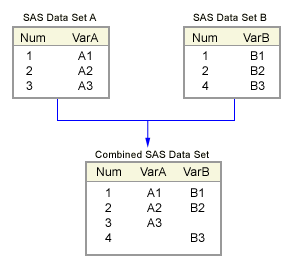

|
|
 |
|
 |
||
IntroductionCombining data horizontally refers to the process of merging or joining multiple data sets into one data set. This process is referred to as a horizontal combination because in the final data set, each observation (or horizontal row) will have variables from both input data sets. |

| It is useful to combine data horizontally if you have several data
sets that contain different but related information. For example, suppose
you have one data set that contains employee data with the variables
There are several methods for combining data horizontally. This lesson focuses on several methods of combining data horizontally in the DATA step, and compares a DATA step match-merge with a PROC SQL join. |
Time to CompleteThis lesson contains pages and takes approximately 1.5 hours to complete. |
ObjectivesIn this lesson, you learn to
|
PrerequisitesBefore taking this lesson, you should complete the following lessons:
|
| Copyright
© 2003 SAS Institute Inc.,
Cary, NC, USA. All rights reserved. Terms of Use & Legal Information | Privacy Statement |
||